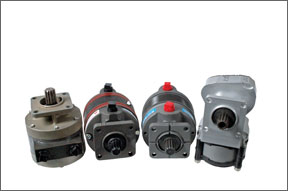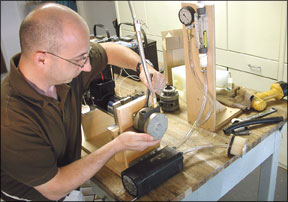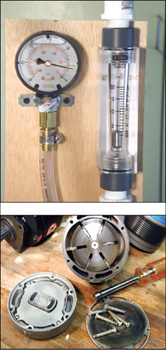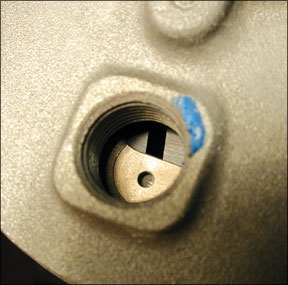Sometimes wh

stuff because it unleashes the demons in places where we would prefer not to confront them, like bumping over the Appalachians at night in light mixed icing with a passenger asking if everything is OK.
But now we do know and we’ll have to deal with it. The way to do this, we think, is to buy the best vacuum pump you can afford, install it correctly, do the required maintenance and replace it before it explodes, as it inevitably will if it accumulates enough flight hours. But which vacuum pump actually is the best and how long might you reasonably expect it to last? To find out, we rounded up the current offerings on the pump market and put them to the test. In our view-and weve waited years to be able to say this-all these products suck. Some suck a little better than others, but all will deliver enough vacuum to stand up the gyros so theyll do their part in keeping you upright in the clouds.
Performance is less the issue here than longevity and reliability. The companies that make pumps know that the overarching concern is avoiding inflight or premature failures and theyve directed their development dollars accordingly. Aero Accessories, for instance, introduced the wear port inspection idea for its Tempest pumps, so you can look at the carbon vanes and replace the pump before it fails. Rapco followed with its own version of the wear port. Two years ago, Sigma-Tek went radical with the introduction of the Aeon pump, a design that uses a single-cylinder reciprocating piston rather than whirring carbon vanes.
We surmised that all of these pumps perform similarly and they do. But what we really wanted to know was does the more expensive piston pump have a performance advantage over the dry vane models-it does-and will it last longer? (It might, but we cant say until it accumulates more service history.)
Six Choices
The current 200-series pump market is defined by six products. Rapco sells overhauled Airborne pumps and its own new production pumps with the aforementioned wear port; Aero Accessories has the Tornado dry vane pump with

wear port; Sigma-Tek offers the piston Aeon product and has just reintroduced its well-regarded dry vane pump. Another company, Arizona Aircraft Accessories, sells bargain-priced overhauled pumps for both 200- and 400-series applications. Two companies-Airwolf Filter Corp. and M20 Turbos-sell wet pumps, but those are the subject of a separate article. Were focusing on dry pumps this time around. We asked each company to send us a sample product for bench testing in our shop. Sigma-Tek and Aero Accessories followed through, but Rapco and Arizona Accessories didnt. We obtained a new Rapco pump from our local maintenance shop for inspection, but we werent able to test it. We did try a rebuilt Rapco pump, however.
To test the pumps, we fabricated a static test stand, driving the pumps with a 1/4-HP DC motor through a variable DC power supply. This allowed us to vary pump RPM from 700-simulating a low idle-to 3500 RPM, which is just a bit slower than a typical six-cylinder engine would drive the pump. Pump speeds for four-cylinder engines are usually 1 to 1, so we also tested at speeds between 2000 and 2400 RPM. To measure output, we plumbed the pump with a standard vacuum directional gyro, a fixed valve to serve as a regulator and a King flow meter to measure air volume through the system. To measure vacuum pressure, we installed a glycerin-filled vacuum gauge, which damped the pulses from the pumps, especially the Sigma-Tek piston design.
The chart at left summarizes the test results. We didnt expect to find any wide variation in pump performance-and we didnt-but we were curious about the acid test for any pump: How we’ll will it spin up the gyros when youre idling at the runway, awaiting your IFR release to launch into the clag? The inflight corollary is what happens when you pull the throttle to idle for a descent. Will there be enough air available to keep the AI and DG from becoming lazy? The short answer is yes, although most of the pumps don’t have surplus performance at idle.
Inflight idle isn’t much of a worry in an aircraft equipped with a constant speed prop. Ignoring the mythical shock cooling, if you pull the throttle to idle, the prop governor will still allow the airstream past the prop to drive the engine at or near

166
the governed speed selected, which is likely to be at least 2200 RPM. In an airplane with a fixed-pitch prop-likely to be a four-cylinder engine-we think its possible that a long idle could depress vacuum output enough to bog the gyros, but we would be surprised if they rolled over as a result.
If thats a worry for you, the Sigma-Tek Aeon piston might be your product. While output from the vane pumps degraded gracefully as we reduced RPM, the Aeon continued to puff away at 4 inches/Hg and 2 CFM down to about 500 RPM, at which point the fuse in our power supply fried. At these low speeds, the vane pumps-including Sigma-Teks-delivered between 1 and 3 inches/Hg and between 1 and 3 CFM. This is sufficient to operate gyros, but its marginal. Weak gyros might balk.
At the upper end of the scale, all of the pumps have air to spare. For example, at 3500 RPM, the Aeon could generate 6 inches/Hg and 3 CFM when wide open and unregulated. The Rapco overhaul, Tempest Tornado and Sigma-Tek dry vane pump were comparable. Even an old Sigma-Tek dry pump, with 700 hours on it, ginned up 5 inches and 2 CFM.
Several things surprised us about these trials. One, vacuum pumps are surprising noisy. Our DC motor drive was as silent as a submarine, but even at simulated slow cruise of 2200 RPM, the pumps delivered a piercing 92 dB buzz. At 3500 RPM, ear protectors were a must. The Sigma-Tek piston pump was a bit quieter, but it vibrated more, requiring the test jig to be clamped to the bench. Last, vacuum pumps heat up quickly and run hot. After a 22 minute run, one of the pumps was at 205 degrees F.
Cost Analysis
With performance of these pumps functionally close to dead even, the larger cost/value issue is which lasts longest? Is one more likely to deliver more hours of service than another? We cant offer a definitive answer to this yet. On paper, Sigma-Teks Aeon pump appears to us to be a contender for the best performing dry pump. The company is offering a five-year/2000 hour warranty, which is practically a full-engine TBO warranty. This, coupled with the fact that Sigma-Tek is pursuing a design for piston-type 400-series pumps, indicates high confidence in the product concept. As we go to press, Aircraft Spruce and Specialty is offering a $595 special price on the Aeon piston pump, otherwise, suggested retail is $895.
At the lower price, the Aeon pump is $136 more than Sigma-Teks standard dry vane pump, which the company has brought back into production because many owners prefer it over the piston pump or the piston version wont fit their application. Sigma-Teks IU128-006 sells for $459.95 discounted. In contrast, Rapcos rebuilt 200-series pumps-overhauled units with no wear port-sell for $189.95 and Rapcos new-manufacture pumps with the wear port are $271.95, both discounted prices. Rapco pumps have a one year/1000 hour warranty.
Aero Accessories Tempest dry pumps are quite a bit more expensive than either the Sigma-Tek models or Rapcos. New 200-series Tempest pumps sell for $615 to $652.50 (discounted) and carry a three-year, 1300-hour warranty. Aero Accessories pioneered the wear port idea in the Tempest pumps and shortly thereafter, Rapco introduced its own version. The Rapco wear inspection port is easily accessible on the top of the pump with vane wear measured by a provided gauge called a “Smart Stick.”
On the 200-series Tempest pumps, the wear port is on the back of the pump, which can be more difficult to get to and may require removal of the pump for inspection. The port consists of a removable plug through which the vane wear can be estimated through a peep hole. Once you know what youre looking at, its easy to see the vane wear. Tempests 400-series pumps use a wear gauge through the side of the pump, similar to Rapcos. Despite the access issue, we prefer the peep hole design because its less ambiguous to judge vane wear. At the bottom of the price pyramid is Arizona Aircraft Accessories, which sells overhauled 200-series pumps through Aircraft Spruce for $208.95 to $299 and 400-series pumps for $444.95 to $447.95. Since the company didnt send a sample, we cant comment on performance, but the AAA warranty is one year or 1000 hours, which strikes us as reasonable, given the discount price.
Conclusion
The goal of our test was to determine if Sigma-Teks piston pump beats conventional vane-type pumps in output, especially at idle power settings. It does. The Aeon is also a well-made pump, nicely machined from aluminum. At $895 list-$595 from Aircraft Spruce-its a tad pricey, but the generous warranty takes the sting off that, as does the Aircraft Spruce temporary discount.
We would like to see some more service history before anointing the Aeon king of all dry pumps. It vibrates more than the rotary pumps and Sigma-Teks Jim Hearn told us there have been a smattering of early failures, some in the drive train mechanism for the piston. Sigma-Tek is working on fixes for this, so we would wait a bit before jumping into this one, just to see how the service pattern shakes out. Sigma-Tek has proven to be a standup company and were confident it wont stick customers with a service can of worms on the new pump.

Meanwhile, the three other contenders-Rapcos new 200-series models, the Tempest Tornado and Sigma-Tek dry-vane pump are separated by both some subtle quality differences and by price. Were surmising that the Rapco new pumps perform similarly to the overhauled model which we tested. The Sigma-Tek didnt quite match the output of the Tempest or the Rapco, but we like its aluminum rotor and composite vanes, which improve durability at a price thats $200 below the Tempest. But alas, no wear port in the Sigma-Tek.
Thats what you pay extra for in Tempest Tornado, along with an improved oil seal system at the front of the pump, says Aero Accessories Tim Henderson, who has spent years refining the design to reduce failures to a statistical minimum. The wear port allows for informed proactive replacement and overall, we think the Tempest is the most refined of the vane pumps, albeit at the highest price point.
For an airplane that has a pump but is never flown in IMC, we don’t see the sense of buying a gold-plated vacuum pump. In this case, Rapcos overhauled Airborne pumps for under $300 (some under $200) are the hands down best value. You can change them proactively every three or four years for the cost of a fill-up. If you fly a lot of cross country trips on weekends where replacement of failed pump will be a non-starter, buy an extra one and carry it in the baggage compartment. Its cheap insurance.


